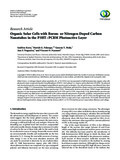| dc.contributor.author | Keru, Godfrey K. | |
| dc.contributor.author | Ndungu, P. G. | |
| dc.contributor.author | Mola, G. T. | |
| dc.contributor.author | Nogueira, A. F. | |
| dc.contributor.author | Nyamori, V. O. | |
| dc.date.accessioned | 2021-03-15T13:20:29Z | |
| dc.date.available | 2021-03-15T13:20:29Z | |
| dc.date.issued | 2015-12-02 | |
| dc.identifier.citation | Journal of Nanomaterials Volume 2016, Article ID 5923402, 11 pages http://dx.doi.org/10.1155/2016/5923402 | en_US |
| dc.identifier.uri | https://www.hindawi.com/journals/jnm/2016/5923402/ | |
| dc.identifier.uri | https://www.researchgate.net/publication/289367367_Organic_Solar_Cells_with_Boron-_or_Nitrogen-Doped_Carbon_Nanotubes_in_the_P3HT_PCBM_Photoactive_Layer | |
| dc.identifier.uri | https://dl.acm.org/doi/abs/10.1155/2016/5923402 | |
| dc.identifier.uri | https://www.semanticscholar.org/paper/Organic-solar-cells-with-boron-or-nitrogen-doped-in-Keru-Ndungu/cdee5041af63d3bdaf3cb442ed67d1627a28b231 | |
| dc.identifier.uri | https://core.ac.uk/reader/296760600 | |
| dc.identifier.uri | http://hdl.handle.net/123456789/4537 | |
| dc.description | http://dx.doi.org/10.1155/2016/5923402 | en_US |
| dc.description.abstract | Either boron- or nitrogen-doped carbon nanotubes (B- or N-CNTs) were incorporated in bulk heterojunction organic solar cells photoactive layer composed of poly(3 hexylthiophene) (P3HT) : (6,6)-phenyl-C61-butyric acid methyl ester (PCBM). The physical and chemical properties were investigated using different spectroscopic techniques. The cell performance was followed from their current-voltage (𝐽-𝑉) characteristics. Recombination dynamics of the photo-generated free charge carriers were investigated using micro- to milliseconds transient absorption spectroscopy (TAS). Transmission electron microscopy (TEM) images revealed the presence of cone structures and bamboo compartments in B-CNTs and N-CNTs, respectively. X-ray photoelectron spectroscopy (XPS) revealed very little boron was substituted in the carbon network and presence of pyrrolic, pyridinic, and quaternary species of nitrogen in N-CNTs. 𝐽-𝑉 characteristics were found to be similar for the devices with B- and N-CNTs even though boron- and nitrogen-doped CNTs are known to have different properties, that is, p-type and n-type, respectively. TAS results showed that all devices had long lived free charge carriers but the devices with B- or N-CNTs had low power conservation efficiency and voltage. | en_US |
| dc.language.iso | en | en_US |
| dc.publisher | Hindawi Publishing Corporation | en_US |
| dc.title | Organic Solar Cells with Boron- or Nitrogen-Doped Carbon Nanotubes in the P3HT : PCBM Photoactive Layer | en_US |
| dc.type | Article | en_US |

